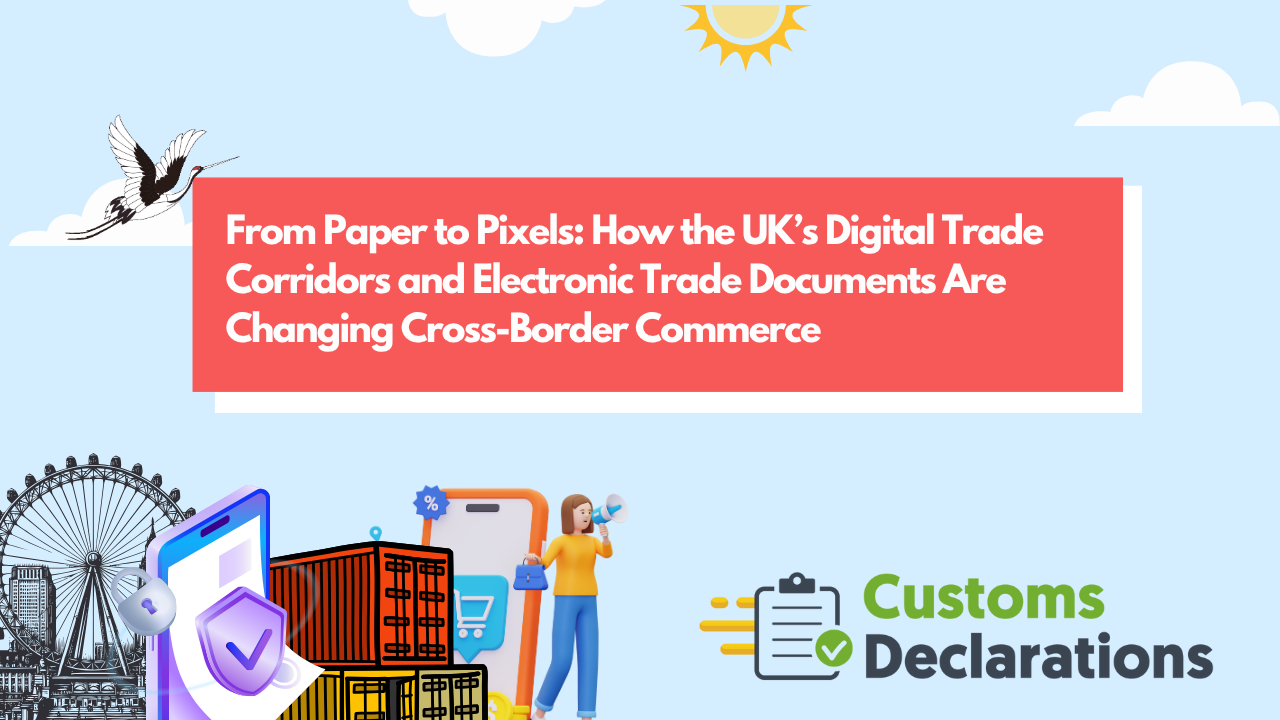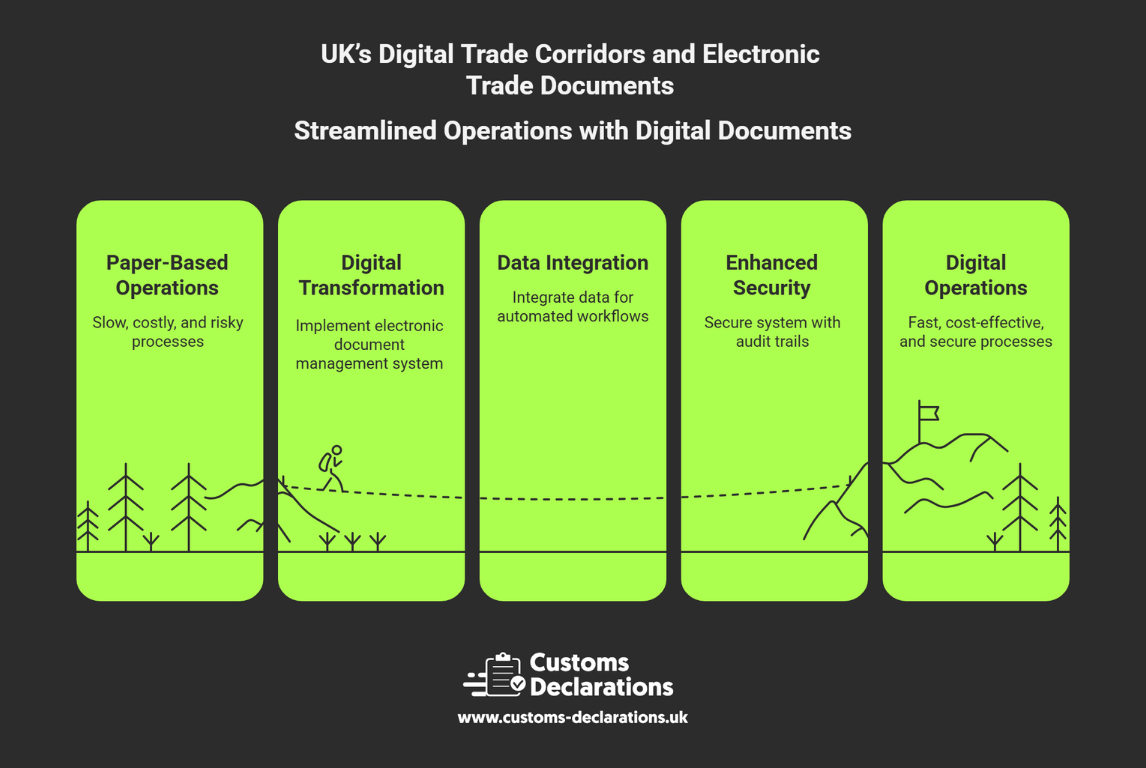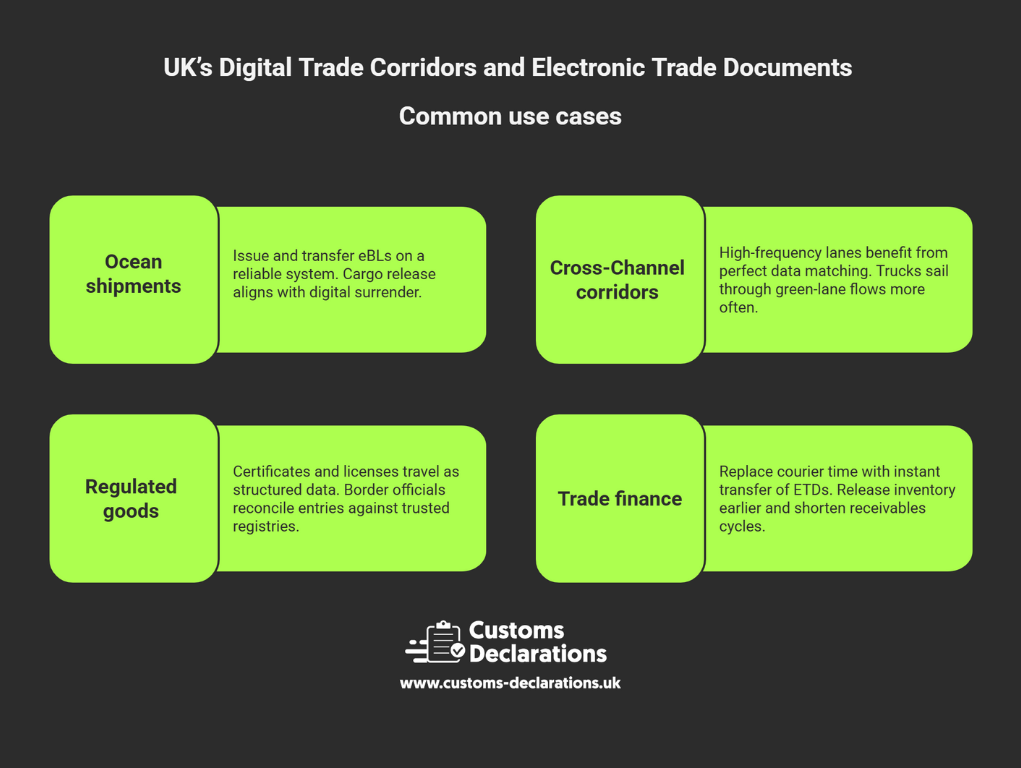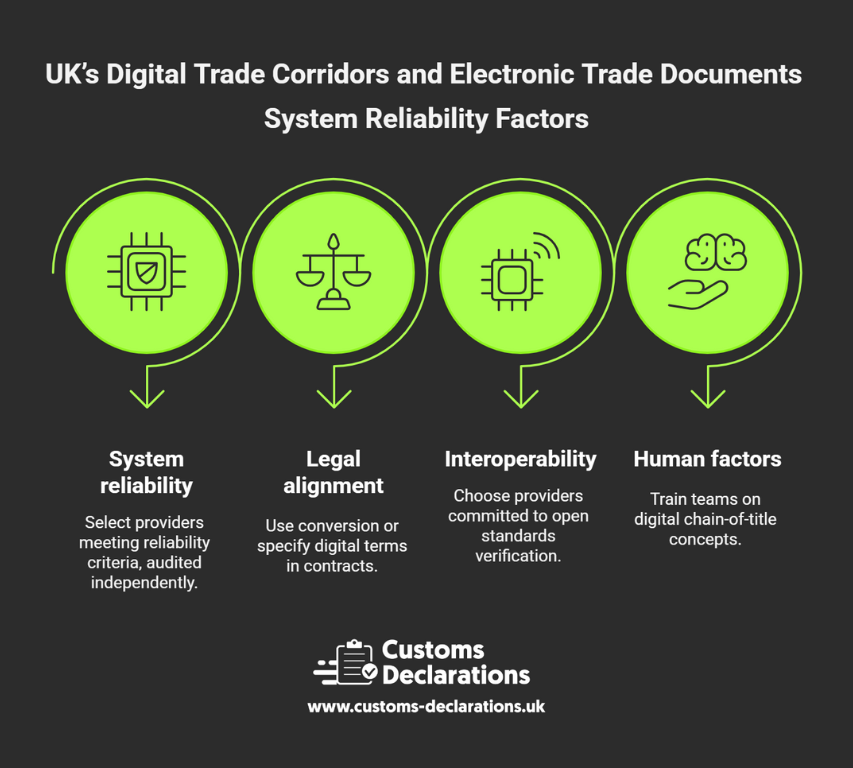Introduction: Trade’s paper problem meets its digital moment
For decades, international trade has been powered by world-class logistics—and slowed by nineteenth-century paperwork. Title documents, letters of credit, certificates and invoices shuttle between banks, carriers, forwarders and authorities, often copied, couriered and rekeyed multiple times. The result is delay, cost, fraud exposure and barriers for smaller exporters. The United Kingdom has decided to break the cycle. Two streams of reform are converging: digital trade corridors that connect public and private systems end-to-end, and legal recognition of electronic trade documents (ETDs) under the Electronic Trade Documents Act 2023 (ETDA). Together, they set the stage for legally robust, machine-readable trade that moves at network speed.
This article explains what digital trade corridors are, how ETDs work in law and in practice, where pilots are emerging, and what all of this means for day-to-day customs and logistics. It closes with a practical section on filing customs declarations via Customs Declarations UK (CDUK) so your import declarations, export declarations, CDS declarations, and ENS declarations are ready for a border that increasingly prefers data to paper.
What exactly is a digital trade corridor?
A digital trade corridor is a live trade lane—typically between two or more jurisdictions—where the commercial, regulatory and logistics information underpinning a shipment is exchanged electronically, in structured form, and trusted by all parties. It is not a single platform; it is an interoperable fabric linking exporters and importers, carriers and ports, banks and insurers, customs and other border agencies. In a mature corridor:
- Transferable documents (e.g., bills of lading, warehouse receipts) exist natively as electronic trade documents rather than scans.
- Pre-arrival safety filings, ENS declarations, and customs entries are submitted once from clean source data and re-used by agencies.
- Trade finance events (presentation, acceptance, payment) are triggered by verifiable data objects rather than paper packets.
- Each actor’s system talks to the others through standards-based APIs, with strong identity, time-stamping and audit trails.
The UK’s corridor approach is pragmatic: prove the model in real lanes, with real shipments, while the legal plumbing (ETDA and international recognition of ETDs) removes the last excuses to revert to paper.
The legal cornerstone: electronic trade documents with teeth
The Electronic Trade Documents Act 2023 solved a fundamental problem of English commercial law: how to confer the paper-world concept of “possession” on a digital document that represents rights (especially bills of lading and bills of exchange). The Act gives qualifying electronic documents the same legal effect as their paper equivalents, provided they are created and managed on a reliable system that ensures uniqueness, integrity, exclusive control and an auditable chain of transfers.
Two features make this consequential for operations:
1) Transfer that actually transfers.
In the paper world, indorsement and delivery of an original bill of lading or warehouse receipt moves control of the goods. Under the ETDA, the same is true for the electronic form: transfer means the transferee gains control and the transferor loses it. This is the difference between a mere “copy” and a transferable electronic original you can finance and surrender.
2) Conversion to and from paper.
Because global adoption is uneven, the Act allows conversion between paper and electronic forms with clear rules. That flexibility lets firms operate digitally where possible but still comply with counterparties or jurisdictions that are not yet ETD-ready.
Crucially, the Act is technology-neutral. It does not prescribe blockchain or a specific vendor; it describes reliability outcomes—governance, security, exclusivity and verifiability—which can be met by several architectures. This neutrality unlocks competition and innovation while keeping courts focused on outcomes that matter in disputes.
Standards and interoperability: how corridors scale
Laws enable; standards scale. The UK’s legal stance aligns with the UNCITRAL Model Law on Electronic Transferable Records (MLETR), which many countries are adopting. On the technical side, the ICC’s Digital Standards Initiative (DSI) and the WTO’s Toolkit for Cross-Border Paperless Trade are converging industry and government around common data models, identifiers and messaging profiles. The practical takeaway is simple: choose tools that support open identifiers (e.g., LEIs for entities), interoperable eBL formats, and machine-readable documentary requirements. This ensures documents created in one system can be verified, transferred and surrendered in another without re-keying.
What the UK is actually building: pilots, sandboxes and corridors
Policy statements now translate into working lanes. The UK has prioritised pilot corridors with leading partners, linking port community systems, eBL providers, financiers and customs single windows. Early efforts focus on electronic bills of lading and accompanying trade documentation, because replacing couriered originals yields immediate speed and cash-flow benefits. As corridors mature, the scope expands to conformity certificates, SPS documents and licences exchanged as structured data rather than PDFs. The public sector role is to coordinate standards, signal acceptance, and modernise border systems so pre-lodged digital data receive faster risk decisions.
Why this matters for your operations: speed, cost, certainty
The business case is tangible:
Time to release and time to cash improve because transferrable originals and required data arrive before the vessel or truck. Finance can be triggered on electronic presentation rather than waiting for courier deliveries.
Cost falls as printing, dispatch, document chasing and discrepancy resolution drop. Less manual handling means fewer typos and fewer rejections.
Fraud and loss risk shrinks when documents live on reliable systems with audit trails and strong identity—counterparties verify by data, not by “wet-ink vibes”.
Sustainability improves by cutting paper and document logistics, while richer data enables carbon-aware routing and inventory decisions.
For SMEs, corridors and ETDs reduce complexity: one clear set of steps, fewer intermediaries, and digital records that satisfy banks and authorities first time.
Data is the new paperwork: making filings fit the digital border
Digital corridors thrive only when filings draw from the same clean data spine. Three disciplines make the difference:
Customs-fit product data.
Descriptions that state what the thing is and does, composition where relevant, and intended use—mapped to justified HS codes with evidence. This prevents misclassification flags from customs risk engines and avoids avoidable interventions.
Plausible valuation and quantities.
Commercial invoices must reconcile logically with shipment contents; declared unit values should align with market ranges; incoterms need to match the cost breakdown. Predictive border systems are good at spotting improbable patterns.
Pre-advised safety and security filings.
With the EU’s ICS2 now fully phased in across modes, ENS declarations should be accurate, timely and machine-readable so partners can risk-assess early. The UK’s border modernisation pulls in the same direction: data early and data right.
Filing customs declarations the smart way with Customs Declarations UK
Even with world-class logistics partners, your experience at the border depends on one thing: the quality of your filings. A practical route to “right first time” is to standardise and validate data once, then reuse it everywhere. That is what the CDUK digital customs platform is built to do.
Capture once, reuse everywhere.
CDUK collects master data (products, partners, licences, valuation elements) and pushes the same validated dataset into CDS declarations for UK legs, and into EU-facing import declarations, export declarations, and ENS declarations via integrated partners—no parallel spreadsheets, no retyping.
Structure and validation by design.
The platform enforces customs-fit product descriptions and unit/quantity coherence, manages HS governance with versioned evidence, and checks document codes and licences ahead of time. That eliminates the “nil-yield hold” caused by missing or inconsistent details.
Pre-lodgement and timelines.
Because corridors reward early, machine-readable data, CDUK supports pre-advice and integrated workflows so your customs and safety filings arrive when authorities want them—before the vehicle gets to the terminal.
Audit and evidence, one click away.
With corridors and ETDs, auditors expect verifiable records. CDUK stores proofs (supplier declarations, conformity certificates, origin statements) in an organised repository you can attach or present on demand. That keeps post-clearance queries short and focused.
For practical how-tos on classification, valuation and origin evidence, the CDUK Knowledge Base walks your team through each step so every customs declaration is consistent, justified and easy to defend.
Common use cases: where you will feel the change first
Ocean shipments under eBL.
You issue and transfer a native electronic bill of lading on a reliable system. The consignee presents it electronically at destination; cargo release aligns with the digital surrender, not courier lead times. Banks accept electronic presentation; risk teams prefer audit-trailed originals to scanned documents.
Cross-Channel and short-sea corridors.
High-frequency lanes are sensitive to seconds, not hours. When carrier bookings, invoices, ENS data and entry data match perfectly, trucks sail through green-lane flows more often. Discrepancies that once triggered orange-lane checks are prevented upstream.
Regulated goods and SPS traffic.
Certificates and licences travel as structured data. Border officials reconcile entries against trusted registries and pre-validated proofs instead of verifying stamps. That shortens inspections for perishable and time-critical goods.
Trade finance and inventory turns.
By replacing courier time with instant transfer of ETDs, you release inventory earlier and shorten receivables cycles. Liquidity improves without changing your physical supply chain.
Risks and mitigations: design for reliability, not heroics
Digital trade corridors eliminate many paper risks but introduce new dependencies. Mitigate them with deliberate design:
System reliability.
Choose ETD and messaging providers that meet the ETDA’s reliable system criteria in governance, security and continuity, with independent audits and tested recovery plans.
Legal alignment.
When counterparties or destinations are not ETD-ready, exploit conversion (electronic ↔ paper) or specify English law and digital terms in contracts. Avoid “scan-and-hope” PDFs that carry none of the legal benefits of ETDs.
Interoperability.
Favour providers committed to open standards and cross-platform verification. Proprietary islands undermine corridor value and trap documents where they were created.
Human factors.
Train teams on digital chain-of-title concepts. A mis-sent transfer instruction in a reliable system has real consequences—treat it with the same care as dispatching a paper original.
Frequently asked questions
Conclusion: Build your data spine, then let the corridor do the work
The UK’s move from paper to pixels is not a branding exercise; it is a structural shift that replaces courier routes with data routes backed by law. Electronic trade documents make title and finance work online. Digital trade corridors let that trust flow between parties and across borders, automating the drudge and focusing human attention where judgement is needed. For traders, forwarders and financiers, the prize is speed with certainty—fewer interventions, faster cash cycles, and lower total cost to serve.
The work is eminently practical: cleanse master data, adopt ETDs on a reliable system, and file customs declarations from a single source of truth through a platform built for the modern border. Do that, and the promise of digital corridors stops being a pilot and starts being your everyday advantage.




